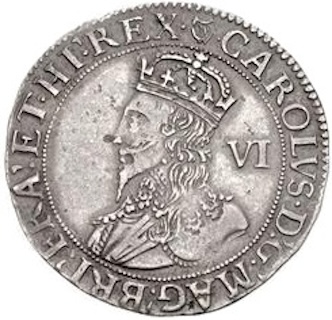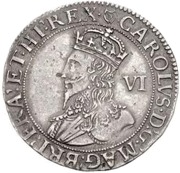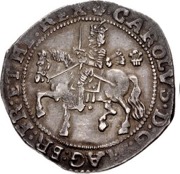
 The 1632 Sixpence - Charles I
The 1632 Sixpence - Charles IKing Charles I silver sixpence, minted in 1632 or 1633 at the Tower (London) mint. Diameter 25mm and weighs 2.99g. Graded as Good VF. SCBC 2811. There's lots of variations of this coin.
The Obverse shows the crowned bust of Charles I. 'VI' to right is a mark of value, meaning six pence. Note the Latin name for Charles is Carolus.
 The Reverse shows a coat-of-arms.
The Reverse shows a coat-of-arms.Image credit: CNGCoins
Mintage: Not known
Minted at The Royal Mint
More information (monarch, year, mint, country, category) can be found below coin listings.
Below are some coins currently being offered on eBay. As an eBay Partner, We may be compensated if you make a purchase.
List items on:
List items on:
Remember 1632 ?
Monarch is King Charles I. The Second Folio of William Shakespeare's plays published. Anthony van Dyck is appointed as the Court painter.
Charles I (1625-1649)
 Charles I was born on 19 November 1600 and was King of England, King of Scotland, and King of Ireland from 27 March 1625 until his execution on 30 January 1649. He was in the House of Stuart.
Charles I was born on 19 November 1600 and was King of England, King of Scotland, and King of Ireland from 27 March 1625 until his execution on 30 January 1649. He was in the House of Stuart.From 1642, Charles fought in the English Civil War against the armies of the English and Scottish parliaments. After his defeat in 1645, Charles refused to accept his captors' demands for a constitutional monarchy. He escaped for a few years but was recaptured by Oliver Cromwell's New Model Army. He was tried for high treason and subsequently executed.
The monarchy was abolished and the Commonwealth of England became a republic. The monarchy would be restored in 1660 by Charles's son, Charles II.
The coinage of Charles I is one of the most interesting periods of English numismatic history. There are a huge amount of varieties and the coins include both hammered and early machine-made coins by Briot. Due to the Civil war many mints popped up around the country. It's a complex and involved subject featuring some outstanding coins. It probably takes an expert to identify a coin correctly.
Category: Sixpences
The Sixpence (half a shilling) was a British silver coin that was first minted 1551 and virtually continuously until decimalisation in 1971. They were often known as 'tanners'. They are small coins, the last minted had a diameter of about 19.4 mm.
Specifications:
- Year Minted: 1551-1970
- Diameter: 19.41 mm
- Weight: 2.83g (1816-1970)
- Edge: Milled
- Metal:
- 1551–1816: Silver
- 1816–1920: 92.5% Silver
- 1920–1946: 50% Silver
- 1947–1970 Cupronickel. Zero Silver
In today's money they are 2½p. It doesn't sound much but at the time it was a weeks pocket money! It was a popular coin when in circulation and is now popular with collectors as it has a long history and many nice specimens can be obtained at affordable prices.
Which Mint: The Royal Mint
The Royal Mint is the designated place for the UK to mint coins. It dates back well over 1000 years and is a Government-owned company. Formed in the reign of Alfred the Great about the year 886, during the period 1279-1812 it was generally referred to as The Tower Mint as it was housed at the Tower of London. The Master of The Royal Mint has included famous figures such as Sir Isaac Newton.
Since 2010 it has operated as Royal Mint Ltd, a company owned by HM Treasury, under an exclusive contract to supply all coinage for the UK although it also produces medals and coins for other countries. It is currently located at Llantrisant, Wales.
Country of Origin: United Kingdom
The United Kingdom (UK) is the Union of England, Scotland, Wales and Northern Ireland. It is often refered to as Great Britain (GBR). It has a long, rich history. The orignal coinage was Pounds, Shillings and Pence but since decimalisation on 15 February 1971, it is £1 = 100p, that is One Pound = 100 pence. The coinage of the UK is also a long history, the Royal Mint being established as long ago as 886AD when coins were hammered. Today there is perhaps 30 billion coins in circulation, and many (numismatic) collectors coins and sets are issued frequently in gold, silver and other metals.








